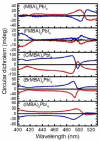Chiral Metal Halide Perovskites: Focus on Lead-Free Materials and Structure-Property Correlations
- PMID: 37630418
- PMCID: PMC10457802
- DOI: 10.3390/molecules28166166
Chiral Metal Halide Perovskites: Focus on Lead-Free Materials and Structure-Property Correlations
Abstract
Hybrid organic-inorganic perovskites (HOIPs) are promising materials in several fields related to electronics, offering long carrier-diffusion lengths, high absorption coefficients, tunable band gaps, and long spin lifetimes. Recently, chiral perovskites have attracted huge interest thanks to the possibility of further widening the applications of HOIPs. Chiral materials, being intrinsically non-centrosymmetric, display several attractive physicochemical properties, including circular dichroism, circularly polarized photoluminescence, nonlinear optics, ferroelectricity, and spin-related effects. Recent studies have shown that chirality can be transferred from the chiral organic ligands into the inorganic perovskite framework, resulting in materials combining the advantages of both chirality and perovskite superior optoelectronic characteristics. As for HOIPs for photovoltaics, strong interest is currently devoted towards the development of lead-free chiral perovskites to overcome any toxicity issue. While considering the basic and general features of chiral HOIPs, this review mainly focuses on lead-free materials. It highlights the first attempts to understand the correlation between the crystal structure characteristics and the chirality-induced functional properties in lead and lead-free chiral perovskites.
Keywords: chiral materials; metal halide perovskites; optical properties; structure of solids.
Conflict of interest statement
The authors declare no conflict of interest.
Figures














References
-
- Wu Z.Y., Jian B.-L., Hsu H.-C. Photoluminescence Characterizations of Highly Ambient-Air-Stable CH3NH3PbI3/PbI2 Heterostructure. Opt. Mater. Express. 2019;9:1882. doi: 10.1364/OME.9.001882. - DOI
Publication types
LinkOut - more resources
Full Text Sources
Research Materials

